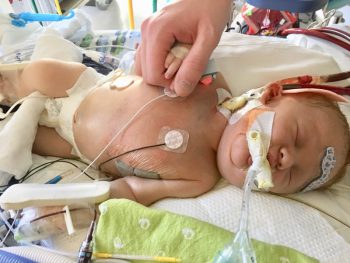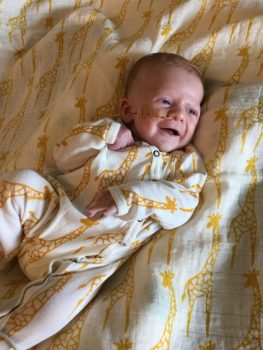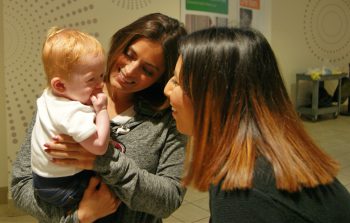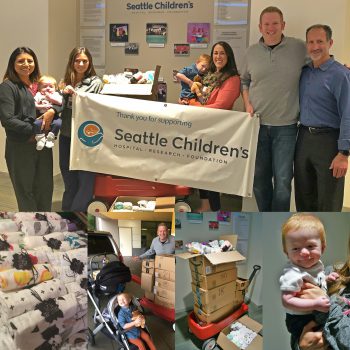
From the moment he made his entrance into the world, Garrett Smith struggled to breathe.
“We longed for that first cry as he was placed upon his momma’s chest,” said Kevin Smith, Garrett’s dad. “Unfortunately, we didn’t get to hear that cry. Instead, we saw Garrett gasping for air and making quiet whimpers.”
As doctors raced to get Garrett the air he desperately needed, they first transferred him to the neonatal intensive care unit (NICU) at the hospital where he was born. When his condition continued to deteriorate, they transferred him to a higher level of care at Swedish First Hill. Less than 24 hours later, the Smiths learned he would need yet another transfer, and faced the scariest decision they ever had to make as parents.
“We had to give Seattle Children’s verbal authorization to put Garrett on a specialized form of life support,” said Garrett’s mom, Erin Smith. “I remember Dr. Kendra Smith reading all of the information about what could go wrong to us over the phone. It was all these scary things that essentially meant death.”
Common complication becomes severe in newborn
Extracorporeal membrane oxygenation, or ECMO, provides the highest level of life support for a baby when their heart or lungs fail. Though there are risks of going on ECMO, the life-saving technology can provide the oxygen babies need when their heart or lungs do not function properly, or need time to heal. Seattle Children’s is nationally recognized as a leading center of excellence in providing this form of advanced type of life support.
Thirty-minutes after he arrived at Seattle Children’s NICU, a cadre of providers gathered around Garrett to put him on ECMO. Garrett had severe pulmonary hypertension, a condition that develops when elevated pressure restricts the blood flow in the vessels between the heart and the lungs. Garrett couldn’t breathe because his lungs weren’t receiving enough oxygenated blood from his heart.
“Pulmonary hypertension in newborns is a fairly common complication,” said Dr. Robert DiGeronimo, the medical director of Seattle Children’s NICU, “but a case as severe as Garrett’s is rare. He was a lot sicker than most babies we see with this condition. We needed to get him oxygenated immediately.”
‘So sick, so fast’

Once supported on ECMO, the team began evaluating why Garrett’s hypertension seemed to be more extreme than most babies.
“Usually pulmonary hypertension in newborns is temporary, but his didn’t get better like it should,” DiGeronimo said. “It also concerned us that Garrett got so sick, so fast. For those reasons, we had to consider that this might be a lethal disease from which he might never recover.”
So at 7 days old, Garrett underwent a lung biopsy, a surgical procedure to obtain a small piece of his lung that would tell doctors more about his condition. He also had genetic testing using a special test offered at Seattle Children’s called whole exome sequencing to rule out possible irreversible genetic conditions.
“Because every bit of progress in the NICU is a big deal, we learned to pray for the little things along the way,” Erin said. “For the next 48 hours, we prayed so hard that the biopsy came back negative – meaning that Garrett’s condition was likely reversible.”
The Smiths learned the preliminary results of the biopsy on Erin’s birthday. The news they received would prove to be a birthday gift she’ll always remember.
“I remember glancing over at the doctor’s notes and the words ‘not lethal’ jumped out at me,” Erin said. “Lethal. That’s such a powerful word when you’re talking about a 10-day-old.”
“We were so grateful and joyous,” Kevin added. “Though Garrett had plenty of hurdles to overcome, it was far from the worst case scenario.”
Time to heal

In addition to showing evidence of severe pulmonary hypertension, the biopsy results showed that Garrett’s lungs were underdeveloped.
“While his lungs were a little on the small side, the biopsy results reassured us that everything was structurally correct,” DiGeronimo said. “He likely just needed time. I felt that if we could get him off ECMO, that he had a very good chance of surviving.”
Even with this promising news, the next five days Garrett remained on ECMO tested every morsel of hope his parents mustered. Another blow came when Garrett’s condition on ECMO suddenly started slipping. His heart had become overworked.
Doctors needed to switch him from the type of ECMO that supported his lungs to another type of ECMO that would also help rest his heart. According to DiGeronimo, about 10% of babies need this additional support after going on ECMO.
“I went numb. I had no tears left to cry and to be honest, much of my hope was gone,” Erin said. “I wanted to hold out all hope, but it was a moment when the NICU roller coaster was just too much for me.”
Hope restored

That night, after learning that Garrett had made it through his third surgery where surgeons connected his ECMO circuit to an artery that would pump oxygenated blood through his body and allow his heart and lungs to rest, his parents went to say goodnight. They found Garrett sleeping peacefully. Once again, they were able to envision going home as a family of four; finally joining Garrett with his 2-year-old brother Griffen.
“Hope had been restored in our hearts again,” Kevin said. “Even in the darkest moments, it was always goodnight and never goodbye.”
As DiGeronimo predicted, Garrett’s health improved over time. To help his blood vessels relax, the NICU team collaborated with cardiologists from Seattle Children’s Heart Center to give Garrett a special pulmonary hypertension drug called treprostinil. Seattle Children’s is among a few hospitals in the country with the expertise to treat critically-ill babies with this medication.
“We reserve this drug for babies with the most severe cases,” DiGeronimo said. “Again, Garrett had such an extreme case that he really needed the medication to get off ECMO.”
Garrett takes his first full breath

After nearly three weeks at Seattle Children’s, Garrett successfully came off ECMO. Four days later, his breathing tube came out. At 20 days old, Garrett finally took his first full breath all on his own.
Flor Garcia, a nurse in the NICU, developed a special bond with the Smiths while she cared for Garrett as his ECMO specialist and primary nurse.
“Slowly Garrett got better, and I worked with Kevin and Erin to create small, but realistic goals to focus on each day,” Garcia said. “We tried to look at the positive in everything and do whatever we could to get him closer to going home.”
Weaning Garrett off the powerful sedatives that had kept him calm on ECMO was particularly hard.
“As a mom, I wanted to make his pain go away,” Erin said. “He was trembling, sweating and constantly throwing up. My kid was sick and there wasn’t anything I could do to make it better.”
But after a few weeks, Garrett was at the end of his roller coaster ride and finally ready to go home for the first time.
“Erin and I found solace in using positive affirmations like, ‘Garrett will come home with us healthy,’ to get through the most challenging moments in the NICU,” Kevin said. “As Garrett got better and we got closer to going home, we felt blessed beyond belief to know that we would be going home, and Garrett would be coming home healthy.”
Bringing comfort to future NICU families

As they were preparing to go home, the Smiths searched for a way to show their gratitude to the doctors and nurses at Seattle Children’s.
“While there’s no real way to say thank you to the people who saved your child’s life,” Erin said, “we wanted to come up with something that would not only make the nurses happy, but also benefit future families.”
Remembering the sense of comfort they felt when they saw Garrett snugly swaddled for the first time after coming off ECMO, they decided to collect swaddle blankets to donate to the NICU. The lightweight muslin blankets were especially needed as Garrett weaned off the sedatives, which caused him to sweat through several blankets in an hour.
The family set out to collect 100 swaddle blankets from friends and family. In August, they surpassed 170 blankets and in September they plan to donate over 200 blankets to Seattle Children’s.
“Little things like blankets are so important to our parents because it gives them a sense of normalcy and something to use to interact with their baby,” Garcia said. “These donated blankets will mean so much to our families.”
“Kevin and Erin were there for Garrett every day. I don’t think they left his side except to eat or go to the bathroom,” DiGeronimo said. “As Garrett got better, it was wonderful to see them transition from being constantly worried that he was going to die to the comfort of knowing that he was going to survive.
Now, they are giving something that will help other families feel that sense of comfort. It’s so meaningful and very much appreciated.”
Resources
- Seattle Children’s Neonatology
- Boy Born With Life-Threatening Condition Rises Up For a Brighter Future

